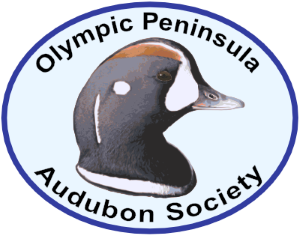Rhinoceros Auklet—Photo: John Gatchet
PUGET SOUND SEABIRD SURVEY
Yellow-billed Loon by Bob Boekelheide
The Puget Sound Seabird Survey is looking for birders on the Olympic Peninsula to join this established Community Science program. Volunteers are asked to conduct 7 surveys with a small team of fellow surveyors at specific coastal locations. All surveys are synchronized to take place once per month on the first Saturday, October – April.
You will be provided training in the survey technique, and ideally will have good seabird identification skills. However, there are roles on the survey team for birders of all levels. Now in its 17th season, you’ll be contributing to valuable science that monitors wintering seabirds across the southern Salish Sea and informs important management decisions.
With the indiscriminate dismantling of federal and state wildlife monitoring programs across the US, your involvement in this project is more important than ever. If interested, please sign up below.
Seattle Audubon’s Puget Sound Seabird Survey (PSSS) is a community science program where volunteer birdwatchers gather data on seabird populations. The program, managed by Seattle Audubon, trains volunteer birdwatchers to gather valuable data on wintering seabird populations in Puget Sound, Strait of Juan de Fuca, and waters surrounding the San Juan Islands.
This geographic area is at high risk of large and catastrophic oil spills and there is limited biological data on the birds that would be most impacted in the event of a spill. The survey team captures a snapshot of live seabird density on more than 5,400 acres of shoreline habitat. It is the only land-based, multi-month seabird survey in the Southern Salish Sea.
OPAS has recruited several volunteers that have participated in this survey. The surveys take place the first Saturday of each month from October until April at or near high tide from Clallam County locations of Diamond Point in the east to Cape Flattery in the west. All data from this survey will be available online along with more information on the Seattle Audubon website.

